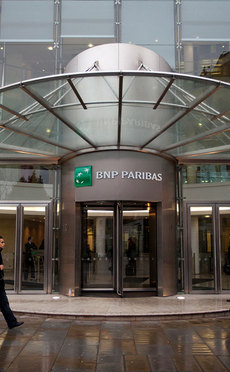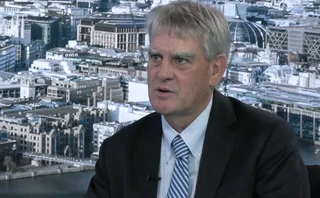
Lifetime achievement award: Yann Gérardin, BNP Paribas
Risk Awards 2017: Understated CIB chief helped build – and protect – today’s BNPP

Ask a trader the secret of their success, and humility is not usually the first item on the list. But it is a word that seems to attach quite naturally to Yann Gérardin, the understated chief executive of corporate and institutional banking (CIB) at BNP Paribas since October 2014. On any given day, you can still find his bicycle chained up outside the bank's headquarters on the Place du Marché St Honoré in Paris.
"Cycling to work is a way to remember life can be difficult: when the wind is against me, I feel – physically – what headwinds mean," he jokes.
Humility is the word he uses to explain two of the defining successes of his career. The first was in 2009, in the months after the worst of the financial crisis. Following massive central bank and government intervention in the final quarter of 2008, investment banks returned to hiring mode during 2009, which ultimately became a record-breaking year for many trading businesses.
In contrast, Gérardin, then head of equities and derivatives at BNP Paribas, hung a vast grey-tinged photo of a desolate, derelict car plant in Detroit in his office. It still covers one wall there today.
"I told people ‘If you don't change, this will be the BNP Paribas dealing room in 10 years' time'," says Gérardin.
It is the hardest moment – when you have to understand everything you have built is much more fragile than you had expected, and given the new circumstances, you have to rebuild everything differently
Yann Gérardin, BNP Paribas
His bet was that a round of post-crisis regulation and higher capital requirements would substantially constrain the balance sheets of the major dealers, to an extent that could not be offset by a rebound in revenues. This prompted him to impose a complete change of strategy on his division, including cost-cutting and shrinking risk-weighted assets (RWAs) and funding needs. His division also "voluntarily gave up" its activities in certain types of exposures such as correlation trades, because he anticipated they would become "untradeable" within a few years. He prioritised the disposal of longer-term products that would otherwise still have been on the books when the regulations tightened.
"It is the hardest moment – when you have to understand everything you have built is much more fragile than you had expected, and given the new circumstances, you have to rebuild everything differently. It is a tough thing to acknowledge, but you have to help your teams also see the privilege in relaunching the business in a different form," he says.
Today, as banks fret over the impact of new Basel Committee rules on market risk, Gérardin's insights looks obvious – but he was in the minority at the time.
"We were following a very difficult path at the beginning. It was a challenge to change the mindset of our staff when some of our competitors were doing the opposite. It is very hard to explain to your teams that they need to cut costs and reduce headcounts when you see most of your competitors are still hiring," he says.
In the end, the transformation left the bank in a position of strength to comply with Basel 2.5 from 2011, and also left it better prepared than peers to cope when the eurozone crisis heated up in 2010 and 2011. By 2012, Gérardin's division was able to begin taking back market share, going on the acquisition path just when other banks were being forced to head for the exits. In October 2013, his team acquired an equity derivatives portfolio worth €12.5 billion from Credit Agricole. Four months later, RBS transferred a structured products portfolio worth €175 billion to BNP Paribas.
An open-minded culture is critical. We were very conscious of maintaining a respectful and thoughtful approach. You need very good collaboration between the two teams – buyer and seller – to make a success of it
Yann Gérardin, BNP Paribas
In a sector marred by some disastrous mergers and acquisitions, especially during the crisis, these two deals helped grow BNP Paribas' footprint without over-burdening its balance sheet. Gérardin again attributes the success to the bank's humble approach. This was vital to maintain co-operation between staff and so preserve the expertise needed to manage the new assets.
"An open-minded culture is critical. We were very conscious of maintaining a respectful and thoughtful approach. You need very good collaboration between the two teams – buyer and seller – to make a success of it," he says.
For BNP Paribas chief executive Jean-Laurent Bonnafé, these successes made Gérardin the front-runner when the then-head of the CIB, Alain Papiasse, took on the role of group general manager for North America in 2014.
"Yann brings a unique mix of skills. He combines the mindset of an entrepreneur with extreme discipline and excellent managerial skills, which enabled him to build a small equity derivatives team into a worldwide leader, and successfully manage the business across the cycles. He has a strong capacity to challenge the organisation, but more importantly, to engage his teams to drive change through the organisation," says Bonnafé.
New frontier
It might seem difficult to develop or preserve an entrepeneurial mindset when working in one of the 10 largest banks in the world, but Gérardin's debut at Banque Nationale de Paris (BNP) in 1987 was in an unusually autonomous role. It was his wife – who joined Credit Commercial de France (now part of HSBC) while Gérardin completed his obligatory military service – who suggested the opening of an equity options market in France might be a great opportunity to enter a new asset class on the ground floor. Gérardin was hired by BNP to set up the equity derivatives team.
"At inception, our main task was to take – on the phone or via telex at that time – orders from the French retail network, which we transmitted to the broker. From there, we gradually grew the franchise," he says.
The bank was behind Société Générale, which launched its equity options team under Antoine Paille in 1986 and received a further boost for its risk-taking traders with the advent of privatisation in 1987. In 1993, it was BNP's turn to exit state ownership under chief executive Michel Pébereau, who retired in 2011 after also serving as the bank's chairman. Privatisation sparked a new strategic plan, including a targeted acquisition in the US to grow the equity options business and catch up with Société Générale. Gérardin led the search, and identified boutique options trader Cooper Neff, which was snapped up in 1994.
"This was really the turning point for us in the equity derivatives field at BNP, because we grew very significantly between 1995 and the end of the internet bubble in 2002," says Gérardin.

The probability at the beginning of the 1990s that French banks would become world-class players in equity derivatives, on a par or even a bit above the major US investment banks, was close to zero. Nevertheless, we succeeded in imposing ourselves
Yann Gérardin, BNP Paribas
What followed in the next decade is still a remarkable transformation, even from today's perspective, when the dominance of French banks in equity derivatives is somewhat taken for granted.
"The probability at the beginning of the 1990s that French banks would become world-class players in equity derivatives, on a par or even a bit above the major US investment banks, was close to zero. Nevertheless, we succeeded in imposing ourselves," says Gérardin.
This rapid emergence is often attributed to the strength of higher mathematics education at the French grandes écoles: Mines, Polytechnique and Gérardin's own alma mater, Hautes Études Commerciales. He agrees this is a factor, but also suggests French banks enjoyed a counter-intuitive advantage from the strength of the cash equity franchises at their US and UK rivals.
"The equity universe in the large US banks was dominated by the cash equity business, which was large enough to keep the attention of the equity managers, while it was much smaller in Europe. We therefore had to focus on developing the structured derivatives business," he says.
This reflected the difference in retail investment cultures between the US and UK – on the one hand – and continental Europe on the other. US and UK private clients were more comfortable taking pure equity risk. By contrast, European portfolios were much more dominated by bond investments. Capital-guaranteed products were therefore essential to help European retail investors rebalance their portfolios towards equities, and this also fed the development of the French structured equity derivatives business.
"In later years, the American banks began to enter more into the structured equity world, but in the meantime, we were able to grow significantly and build barriers to entry that made us relevant for the long term as well. And by then, conversely, we had also begun to move into vanilla flow listed equity derivatives, with some success," says Gérardin.
Growing pains
The development of BNP's business also broadened the role of equity derivatives, from catering largely to the domestic retail network, to serving international corporate clients. The division was able to build through the bank's foreign exchange dealing rooms worldwide, starting in Tokyo in the early 1990s, and later setting up in BNP's Hong Kong and Germany branches, as well as expanding through Cooper Neff in the US.
That growth then received a further, decisive boost when BNP merged with Paribas in 2000. The merger was particularly complementary for the CIB, says Gérardin, as it brought together the BNP corporate lending and equities franchise with the stronger fixed income and specialised financing business at Paribas.
"We created, via this merger, a much bigger, more powerful and relevant CIB for our clients on a worldwide basis," he says.
I needed to protect the culture of professionalism and respect for our clients and other employees. Rapid growth can make it difficult to maintain the culture
Yann Gérardin, BNP Paribas
The rapid expansion presented Gérardin with a personal challenge, however: "I was not a manager to start with, I was a specialist," he says. As the business grew to a large division across continents, he had to consciously develop a management approach to sustain the kind of corporate culture he wanted.
"I needed to protect the culture of professionalism and respect for our clients and other employees. Rapid growth can make it difficult to maintain the culture – if you are hiring hundreds of individuals every year from other banks, and with a turnover of 20%, in just a few years you have totally switched your firm. I became very strict on culture, even at the cost of slowing the growth of the business – I did not want to hire too quickly and jeopardise the culture of the bank," he says.
Integrated model
This is a lesson he was still putting to good use when he was appointed to head the CIB in 2014. One of his first actions was to email every manager personally to ask for their views on how the CIB should develop. The question is one that many of his peers are still asking themselves today, while Gérardin is now very clear on the basic strategic direction for the businesses he leads. This is to make maximum use of the broader BNP Paribas franchise as a large retail and corporate bank across the EU and beyond.
"It is no longer possible to have a standalone CIB strategy – the industry is so challenged with so many requests from regulators that you have to adjust your CIB strategy to the strengths and weaknesses of your group," he says.
In the case of BNP Paribas, the aim is to be one of the top three CIBs in Europe, with a strong footprint across the Americas and Asia. In Europe, Gérardin identifies disintermediation as an important area of focus. The same capital and funding rules that are constraining the bank affect the whole European banking sector, and will oblige corporates to find new ways to meet their funding needs. He expects that trend to reach steadily further into the bank's corporate client base.
Yann has a rare ability. He takes the time to analyse a situation in great depth, he forms a vision, and then he converts that vision into action and galvanises the teams around him to buy in and to deliver
Alain Papiasse, Gérardin's predecessor as head of the CIB
"The European midcaps in 2020 will certainly have less access to bank balance sheet because of the consequences of new regulation – extremely demanding in terms of capital against lending – and consequently will be more financed by the markets. We need to help them have access to the markets, which will make CIB all the more relevant in the long run," says Gérardin.
This means positioning BNP Paribas between its corporate client base and institutional investors. Within weeks of Gérardin's appointment as chief executive of the CIB in 2014, the bank's securities services division – providing custodian and clearing services to an almost exclusively institutional client base – was brought fully under his management.
"Yann has a rare ability. He takes the time to analyse a situation in great depth, he forms a vision, and then he converts that vision into action and galvanises the teams around him to buy in and to deliver. In the current challenging environment, Yann's capacity to adapt has proved its importance: he values the process of transformation to make the CIB more and more competitive," says Alain Papiasse, Gérardin's predecessor as head of the CIB, who is now deputy chief operating officer with responsibility for North America.
The idea, Gérardin explains, is to build a bridge between corporate and institutional clients resting on two pillars, each of which has its processing businesses at the base of the pillar, and the financing at the top.
"[There is] the corporate client franchise pillar, to which we offer cash management, trade finance and financing products all the way to the more long term, more structured financings, as well as advisory; and the other franchise is the institutional one, with the securities services business, and financing via the prime brokerage and repo businesses. We need to have an intimate relationship with the institutional clients to explain to the corporate clients what is doable in today's circumstances and what is not doable – in terms of issuance for instance. This is the role of our Global Markets business, which makes the bridge between our two franchises," he says.
Competitive landscape
Explaining to clients what the bank can do is also a task for the institutional divisions. Although funding conditions have improved since the eurozone crisis, Gérardin's decision to scale back exotic exposures remains intact, which has a knock-on effect on what the CIB is willing to offer to institutional investors.
"Maybe they are good products for some of our clients, but they are too demanding for us: we cannot cope with them while integrating the coming requests of the regulators," he says.
He adds that the bank does identify strategic clients that have the most extensive range of other business with the bank, to whom it could be justified offering more capital- and funding-intensive trades. If the relationship is a "true partnership", as he calls it, the bank is ready to adapt to a very specific need if it is particularly important to a key client.
Yann launched this ambitious transformation plan at a time when many doubted the capacity of European banks to succeed in CIB. And he is delivering on all fronts
Jean-Laurent Bonnafé, BNP Paribas
While some European bankers are expressing concern they will be unable to compete with US peers under the new regulatory regime, the 2016-2019 strategic plan for BNP Paribas CIB includes making specific investments in the Americas and Asia-Pacific. The bank's chief executive, Bonnafé, believes he has the right man to make the difference.
"Yann launched this ambitious transformation plan at a time when many doubted the capacity of European banks to succeed in CIB. And he is delivering on all fronts, strengthening our capacity to accompany our clients at the same time as tackling the issue of cultural change, for example with the introduction of a code of conduct. The sector continues to move, and Yann is now driving through the digital transformation of CIB to ensure we can propose ever more efficient and digital solutions to our clients," says Bonnafé.
Gérardin himself draws inspiration from BNP's emergence against the odds in equity derivatives during the 1990s. Even in the US market, he believes major clients will always have room for a European bank on their panel.
"Large US asset managers or Asian corporates, when they look at their pool of bankers, still need a European bank able to explain the European perspective. We are well positioned to do this, especially as we see some of our competitors retrenching from some core business areas," he says.
That positioning could also serve the bank well in the face of Brexit. With large operations in Paris and other EU cities already, BNP Paribas could relocate specific activities away from the UK more easily than its US rivals. Gérardin is understandably reluctant to venture too far into that particular political minefield, but it seems unlikely he shares the enthusiasm of some EU policymakers for the idea that other European financial centres can benefit if London exits the single market.
"If you are in a cost war, obviously it helps to minimise the cost base. For us, it was one of the three levers of our transformation plan, and intended to give us some room to manoeuvre. The more we can do everything from one centre, the better from a financial perspective," he says.
Open architecture
The new regulatory environment has pushed up more than capital and funding costs. The technological demands are also vast, and Gérardin sees this fuelling another kind of disintermediation process. In the same way that a standalone CIB is no longer practical, nor is a purely in-house approach to technology.
"In the past, technology-wise we did everything internally. Today, it is no longer possible, it is too expensive, so we have to be open to outside infrastructure, to co-creating and collaborating, even in terms of common utilities, even if it seems to be very difficult to create," he says.
He expects back-office functions such as know-your-client (KYC) checks to be the first areas to move to this model. The Society for Worldwide Interbank Financial Telecommunications launched a KYC registry in December 2014, which already has 3,000 banks participating worldwide. But the approach is also relevant for front- and middle-office functions.
We had to anticipate, to add on the potential capital requirements and see what could be the most challenged products and how we could manage them
Yann Gérardin, BNP Paribas
"The CIB setup has to be flexible enough to integrate the best of the outside world, adjusting our world if there is something much better than what we do outside. It is highly likely that in the future the best services will not be 100% BNP Paribas-born. We might need to import some of the services via whatever kind of fintech platform or specific local market-makers into our setup while transacting with our clients, to be able to offer them the best service," says Gérardin.
He is more cautious, however, about the idea of sharing the bank's proprietary risk model technology as a way to enhance client loyalty or engage in some form of open-sourcing to meet new regulatory demands. Goldman Sachs last year began to offer aspects of its front-office risk system SecDB to clients, and JP Morgan plans to follow suit with its own Athena system. Gérardin is concerned about the idea of becoming a "services provider for my competitors," warning it could be "extremely complicated".
"Who knows, however: the model could become more of a utility, because it might be a less important part of the value generation. Then you might move more of the quants to do other things that we would not want to share in a utility, like digital data analysis tools to support our flow product clients, or artificial intelligence expertise," says Gérardin.
What matters, he says, is not having to tell clients you are not in a position to offer them a product from a competitiveness standpoint. This means connecting the BNP Paribas platform to other platforms that might be superior for certain activities, and potentially scaling back the bank's own activity in that area.
"It will be a kind of permanent transformation, following the path of new commerce," says Gérardin. And regulation also seems to require "permanent adjustment to a new world every day", he adds. The final picture is still uncertain, following a fresh delay to completing the Basel post-crisis capital framework.
"More clarity on the rules of the game is key. When we launched the latest CIB strategic plan [in 2016], it set out a vision of what we want CIB to be for the bank and for our clients, but with considerable uncertainty around the consequences of the new regulatory requests. So we had to anticipate, to add on the potential capital requirements and see what could be the most challenged products and how we could manage them," says Gérardin.
Despite all of that, he is considering taking down the photo of Detroit, and replacing it with something a little more upbeat.
Only users who have a paid subscription or are part of a corporate subscription are able to print or copy content.
To access these options, along with all other subscription benefits, please contact info@risk.net or view our subscription options here: http://subscriptions.risk.net/subscribe
You are currently unable to print this content. Please contact info@risk.net to find out more.
You are currently unable to copy this content. Please contact info@risk.net to find out more.
Copyright Infopro Digital Limited. All rights reserved.
As outlined in our terms and conditions, https://www.infopro-digital.com/terms-and-conditions/subscriptions/ (point 2.4), printing is limited to a single copy.
If you would like to purchase additional rights please email info@risk.net
Copyright Infopro Digital Limited. All rights reserved.
You may share this content using our article tools. As outlined in our terms and conditions, https://www.infopro-digital.com/terms-and-conditions/subscriptions/ (clause 2.4), an Authorised User may only make one copy of the materials for their own personal use. You must also comply with the restrictions in clause 2.5.
If you would like to purchase additional rights please email info@risk.net
More on Awards
Collateral management and optimisation product of the year: CloudMargin
Delivering the modern blueprint for enterprise collateral resilience
Flow market-maker of the year: Citadel Securities
Risk Awards 2026: No financing; no long-dated swaps? “No distractions,” says Esposito
Pricing and analytics: fixed income – Quantifi
Quantifi delivers high-performance, transparent and adaptable pricing and risk analytics for fixed income and credit markets
Derivatives house of the year: Citi
Risk Awards 2026: Rev up, RWAs down, as US bank gets back on track (with added XiNG and XiP)
Technology vendor of the year: SS&C Algorithmics
Risk Awards 2026: From cloud, to chips, to maths tricks – vendor getting more out of existing tech
SS&C Algorithmics: winner’s interview with Curt Burmeister
SS&C Algorithmics wins three categories in this year’s Markets Technology Awards in addition to Technology vendor of the year at the Risk Awards
Best vendor for system support and implementation: Murex
Murex wins Best vendor for system support and implementation at the Markets Technology Awards 2026
Pricing and analytics: cross-asset and structured – Murex
Murex wins Pricing and analytics: cross-asset and structured at the Markets Technology Awards 2026 thanks to its MX.3 platform







